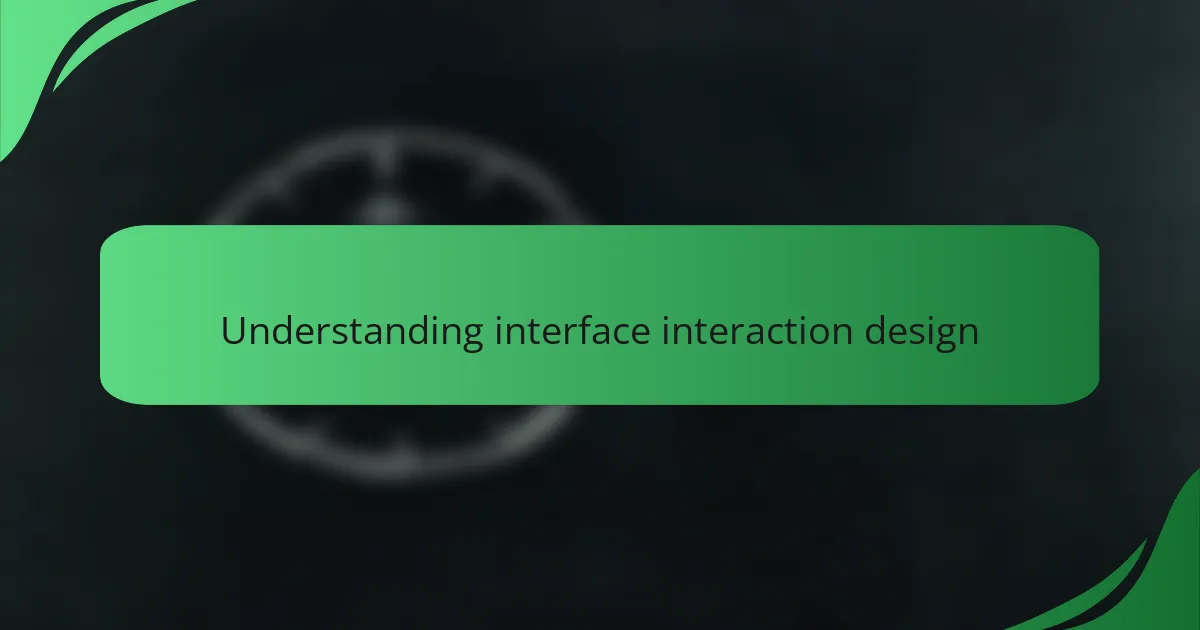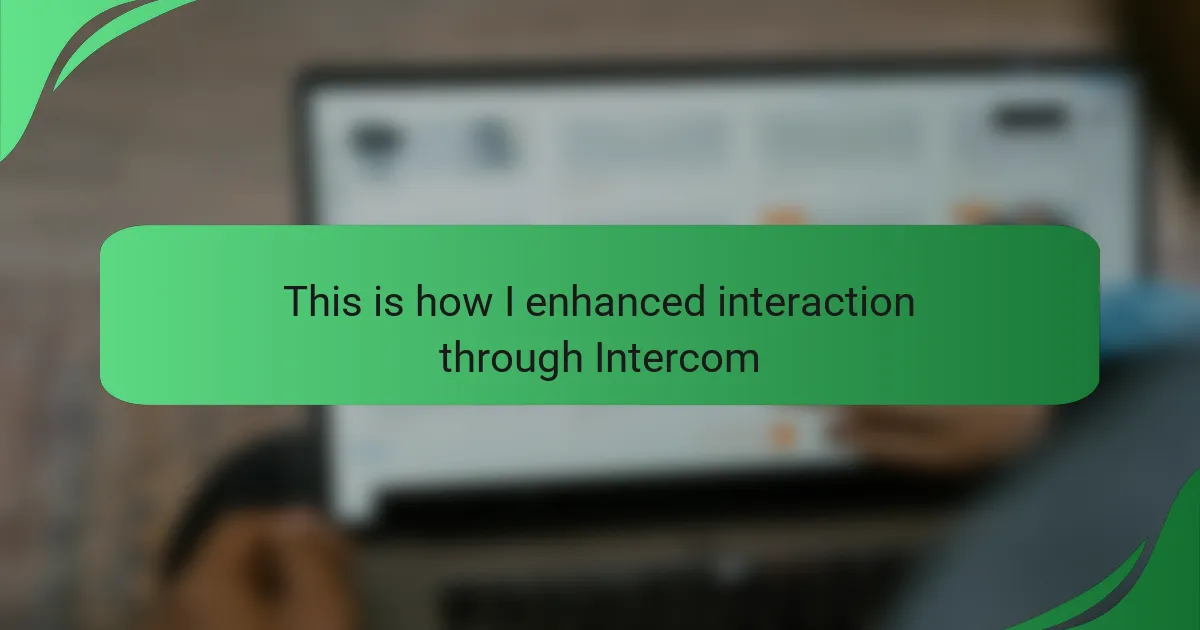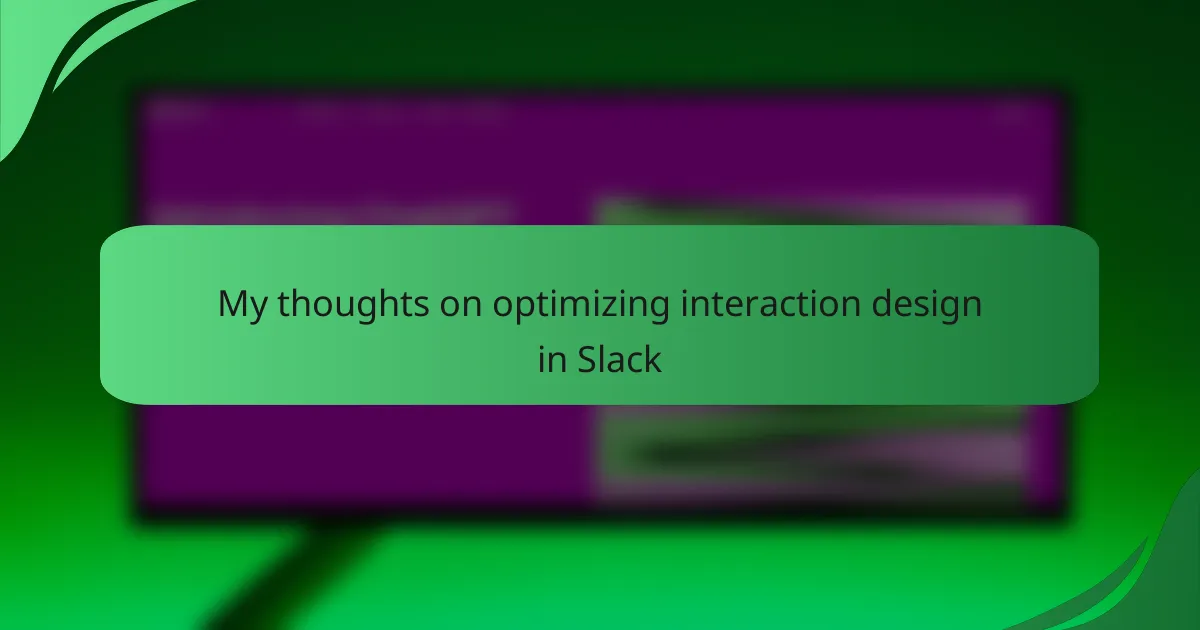Key takeaways
- Interface interaction design significantly impacts user engagement and emotional connection, influencing their overall experience with digital products.
- Effective communication strategies, including empathy in messaging and user feedback prompts, can enhance user participation and satisfaction.
- Utilizing tools like Intercom for features such as live chat and targeted messaging allows for real-time engagement and deeper understanding of user needs.
- Clarity, responsiveness, and empathy are essential principles in creating intuitive interfaces that foster loyalty and improve user interaction.

Understanding interface interaction design
Interface interaction design is all about how users engage with digital products. I often think about my own experiences when navigating websites or apps—how a well-designed interface can make me feel more connected and invested in the task at hand. Have you ever noticed how a seamless interaction can uplift your mood and drive productivity?
In my journey through various design projects, I’ve seen firsthand the impact of intuitive interfaces. Take, for example, a simple button that changes color upon hover; it’s not just a visual cue, but it invites users to explore further. This kind of interaction evokes curiosity and encourages deeper engagement.
Understanding the nuances of interface interaction design involves recognizing these emotional triggers. I’ve found that every design choice, from color palettes to layout, can profoundly affect how users feel about the experience. Have you ever felt frustrated with a clunky interface? That’s a clear reminder of how design shapes our emotions and interactions in the digital realm.

Importance of user engagement
User engagement is a cornerstone of effective interface design. When users feel connected, they are more likely to return, ultimately fostering loyalty and enhancing brand perception. I’ve personally witnessed how increased interaction leads to richer user experiences. For instance, after implementing real-time chat support, I saw a significant uptick in user satisfaction. This engagement transformed how users interacted with our platform, leading to deeper conversations and valuable feedback.
Moreover, understanding user needs through their engagement can shape design decisions. I often find myself adapting features based on user interaction patterns. The more engaged the users, the clearer their preferences become, which in turn helps refine both the product and communication strategies.
| Engagement Technique | Impact on User Experience |
|---|---|
| Direct Messaging | Fosters real-time communication and quick problem resolution |
| User Feedback Loops | Encourages continuous improvement based on user suggestions |

Key principles of effective interaction
Effective interaction hinges on a few key principles that I’ve found essential in my design work. First and foremost, clarity is crucial. I remember redesigning a dashboard that was cluttered with information, and once I streamlined the layout, users finally shared their relief at the clarity it provided. Have you ever experienced that “aha!” moment when information just clicks? That’s what clarity can achieve.
Another principle is responsiveness. Users today expect interfaces to react quickly to their inputs, whether it’s a simple button click or a scroll action. I recall a time when I implemented micro-interactions—small animations that provide feedback during loading processes. The positive reactions were overwhelming; users felt more in control, and it significantly reduced their anxiety about waiting.
Finally, empathy plays a vital role in crafting effective interactions. Understanding the user’s emotional journey is something I prioritize in my designs. I once conducted user interviews that revealed how frustrations with navigational elements could discourage even the most determined users. Recognizing these emotions allowed me to create solutions that resonated more deeply with their experiences, ultimately fostering a more meaningful interaction. Have you ever felt understood by a product? That connection is what keeps users coming back.

Overview of Intercom features
Intercom offers a suite of features designed to streamline communication between businesses and users. One standout feature is the live chat option, which allows real-time interaction. I recall implementing this in one of my projects and watching as user inquiries transformed into instant conversations, creating a bond that felt almost personal. Have you ever had a question answered right when you needed it? That’s the power of live chat.
Another compelling feature is the targeted messaging system. I’ve found that reaching users with personalized content makes them feel recognized and valued. For example, by segmenting messages based on user behavior, I witnessed a notable increase in engagement. It’s like having a conversation with a friend who knows your interests; doesn’t that feel special?
Moreover, the robust analytics that Intercom provides allows me to measure user interactions effectively. Analyzing response times and user feedback helps me adapt strategies quickly. I remember a time when metrics led to an immediate redesign of a chat flow, and the positive impact on user experience was evident. How can we improve if we don’t measure what matters? It’s a game changer in understanding and enhancing user interactions.

Strategies for enhancing communication
Enhancing communication in interface design requires deliberate strategies that foster genuine connections. One approach I’ve found effective is utilizing empathy in messaging. By understanding the mindset of users, I’ve crafted messages that resonate with their needs, much like reaching out to a friend who’s going through a tough time. Have you ever received a message that felt tailor-made just for you? That warmth can transform user interactions into memorable experiences.
Another strategy I swear by is incorporating prompts that encourage user participation. For instance, during a recent project, I implemented feedback surveys directly within the interface. Users appreciated the chance to voice their opinions, and those little nudge moments led to profound insights. It’s amazing how a simple click can turn a passive user into an active participant. Have you noticed how much more invested you feel when you can share your thoughts?
Lastly, creating a cohesive narrative across all touchpoints can tie the entire experience together, making communication feel seamless. I remember working on a project where consistent messaging helped guide users through a complex feature, reducing confusion significantly. Users expressed gratitude for the clarity, and it struck me how storytelling in design elevates engagement. Have you ever encountered a beautifully woven narrative that just clicked? That connection is the heart of effective communication.

Personal experiences with Intercom
When I first started using Intercom, I was amazed at how intuitive the platform was. The ability to directly engage with users in real-time helped me understand their needs and preferences better than I ever had before. I remember a specific instance where a quick conversation resolved an issue for a customer, which not only improved their experience but also motivated my team to refine our support processes.
What struck me the most was the impact of personalized messages. By segmenting users and tailoring communication specifically to their journey, I could create a stronger connection with them. I felt a sense of accomplishment knowing that my messages resonated with users, enhancing their overall experience with our product.
Here’s a comparison table outlining some key features of Intercom based on my experience:
| Feature | My Experience |
|---|---|
| Live Chat | Immediate user feedback and support. |
| Targeted Messaging | Increased engagement by reaching users at the right moment. |
| User Segmentation | Allowed for deeper insights and tailored interactions. |




